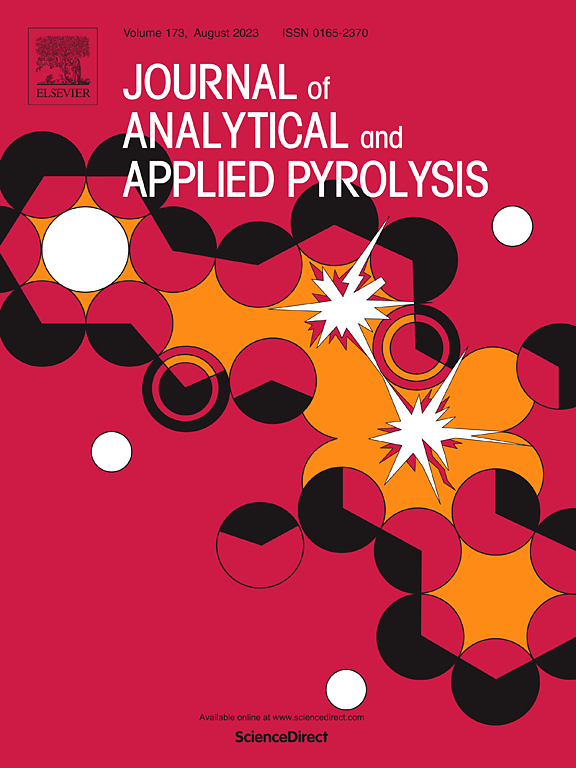热流方向对微波或炉加热玉米秸秆活化过程中气孔发育的影响
IF 6.2
2区 化学
Q1 CHEMISTRY, ANALYTICAL
引用次数: 0
摘要
热传递决定了大体积生物质颗粒中外部/内部有机物的激活顺序。这影响了反应中间体和反应网络的演化,也可能影响了所得活性炭的孔隙特征。本文采用微波加热和电炉加热两种不同传热方向的加热方式,研究了不同活化剂对玉米秸秆髓(CSP)的活化作用。结果表明,微波加热增强了以K2C2O4为活化剂的裂化反应,降低了AC的产率,导致微孔合并,中孔/大孔比例增加(13.3 %比6.4 %)。然而,微波同时加热在ZnCl2活化过程中产生了高密度的反应中间体,促进了缩合,形成了产率更高的AC。聚合物中间体的富集导致大孔隙被堵塞,比表面积较低(1274.0 m2·g−1比1428.1 m2·g−1),但微孔的比例较高(97.1 %比83.2 %),有利于苯酚的吸附。反应中间体的原位红外表征表明,H3PO4不能与CSP形成强交联键(C-O-P)。在300℃以下,K2C2O4的优势裂解减少了-OH和CO等含氧中间体的生成,而ZnCl2可以通过缩合去除这些含氧中间体,从而导致AC的形貌重建。本文章由计算机程序翻译,如有差异,请以英文原文为准。
Influence of heat flow direction on pore development in activation of corn stalk pith under microwave or furnace heating
Heat transfer determines sequence for activation of outer/inner organics in a bulky biomass particle. This affects evolution of reaction intermediates and reaction network, probably also pore characteristics of resulting activated carbon (AC). Herein, this was investigated by activation of corn stalk pith (CSP) with varied activators under microwave heating and furnace heating, two heating method with distinct heat transfer direction. The results showed that microwave heating enhanced cracking reactions with K2C2O4 as an activator, decreasing yield of AC. The enhanced cracking resulted in merge of micropores and higher percentage of mesopores/macropores (13.3 % versus 6.4 %). Nonetheless, simultaneous heating with microwave generated high density of reaction intermediates during activation with ZnCl2, enhancing condensation to form AC of higher yield. More abundant polymeric intermediates led to blockage of large pores, resulting in lower specific surface area (1274.0 m2·g−1 versus 1428.1 m2·g−1) but higher percentage of micropores (97.1 % versus 83.2 %), facilitating adsorption of phenol. In-situ IR characterization of reaction intermediates showed that H3PO4 could not form strong cross-linking bonds (C-O-P) with CSP. Dominant cracking with K2C2O4 diminished formation of oxygen-containing species like -OH and C![]() O below 300°C, while ZnCl2 could remove these oxygen-containing intermediates through condensation, leading to reconstruction of morphology of resulting AC.
O below 300°C, while ZnCl2 could remove these oxygen-containing intermediates through condensation, leading to reconstruction of morphology of resulting AC.
求助全文
通过发布文献求助,成功后即可免费获取论文全文。
去求助
来源期刊
CiteScore
9.10
自引率
11.70%
发文量
340
审稿时长
44 days
期刊介绍:
The Journal of Analytical and Applied Pyrolysis (JAAP) is devoted to the publication of papers dealing with innovative applications of pyrolysis processes, the characterization of products related to pyrolysis reactions, and investigations of reaction mechanism. To be considered by JAAP, a manuscript should present significant progress in these topics. The novelty must be satisfactorily argued in the cover letter. A manuscript with a cover letter to the editor not addressing the novelty is likely to be rejected without review.

 求助内容:
求助内容: 应助结果提醒方式:
应助结果提醒方式:


